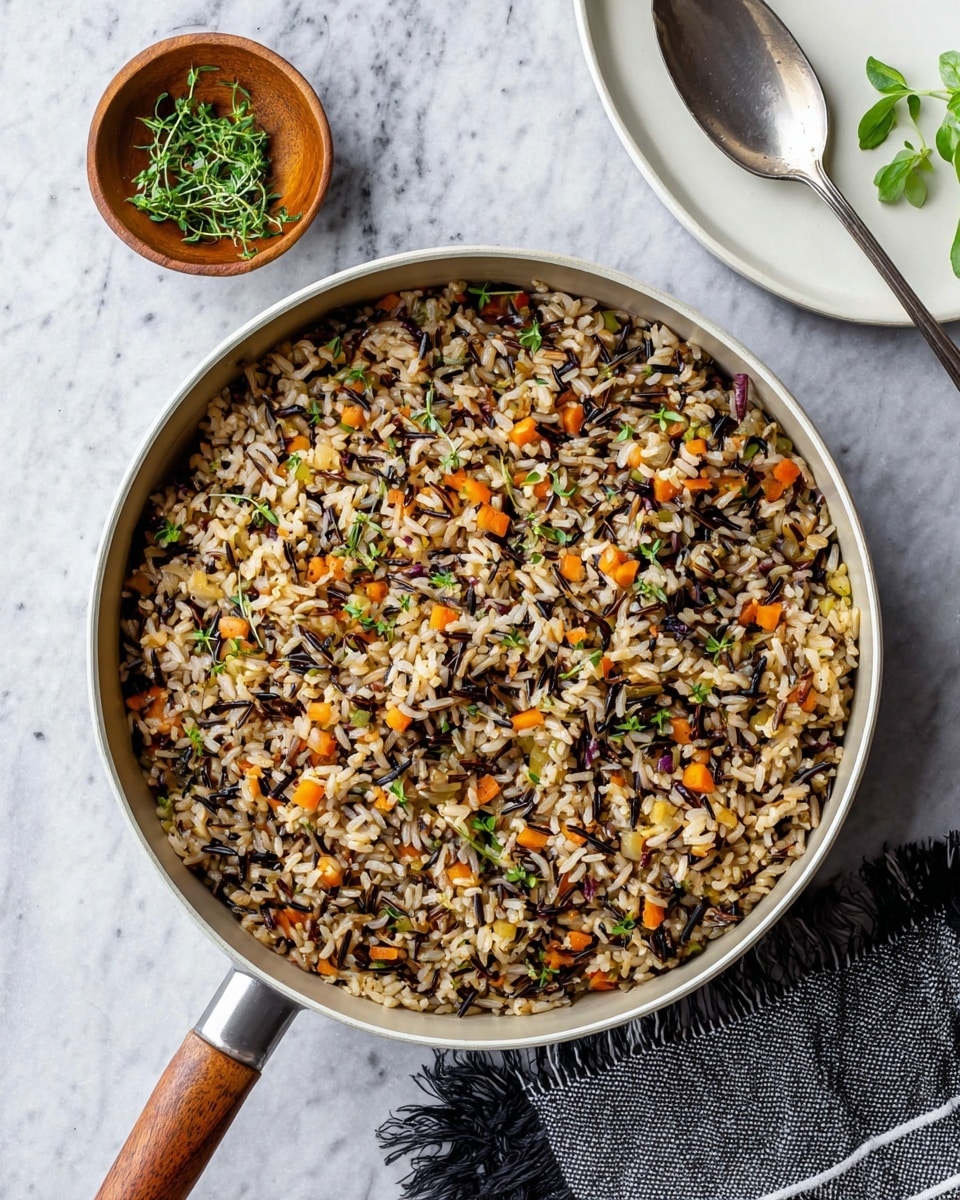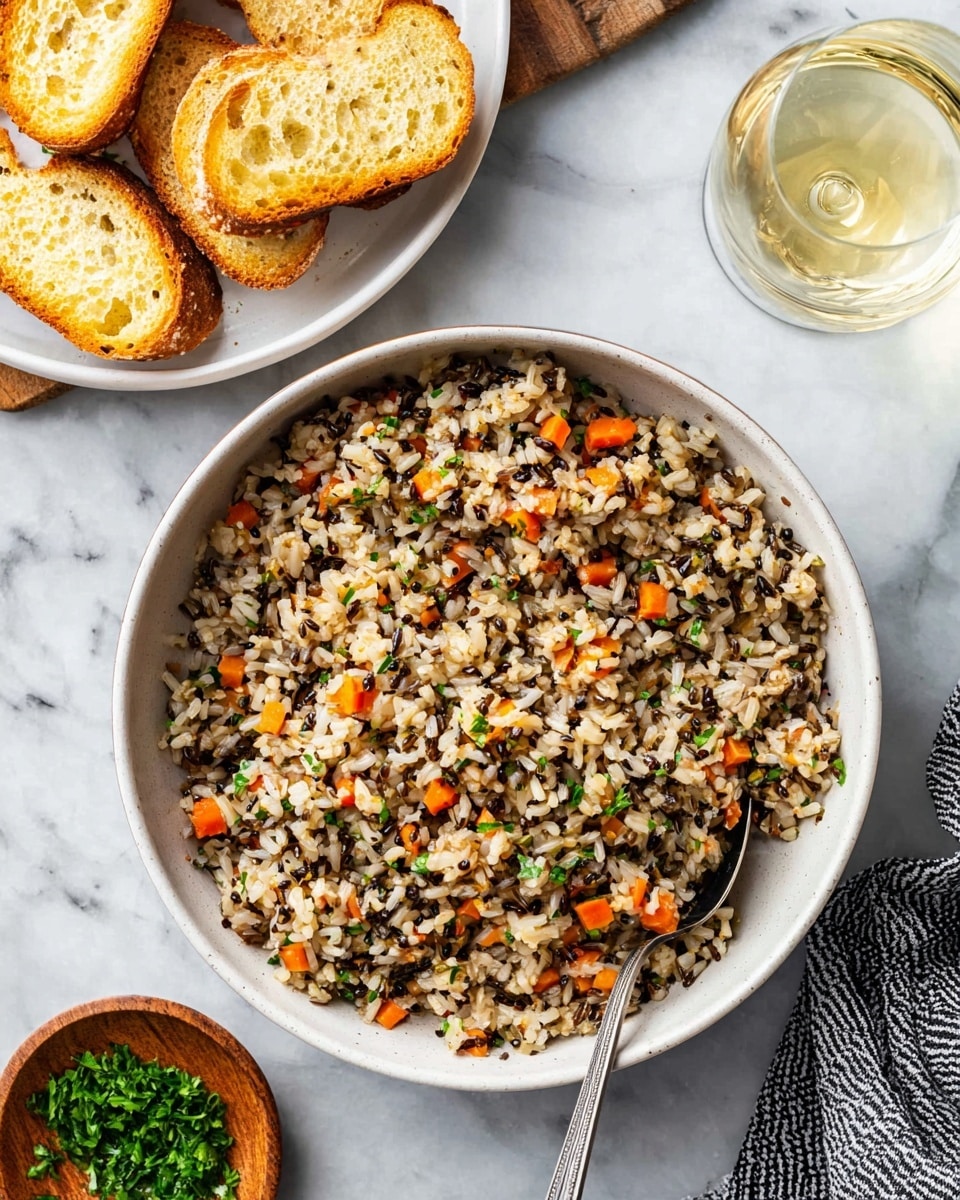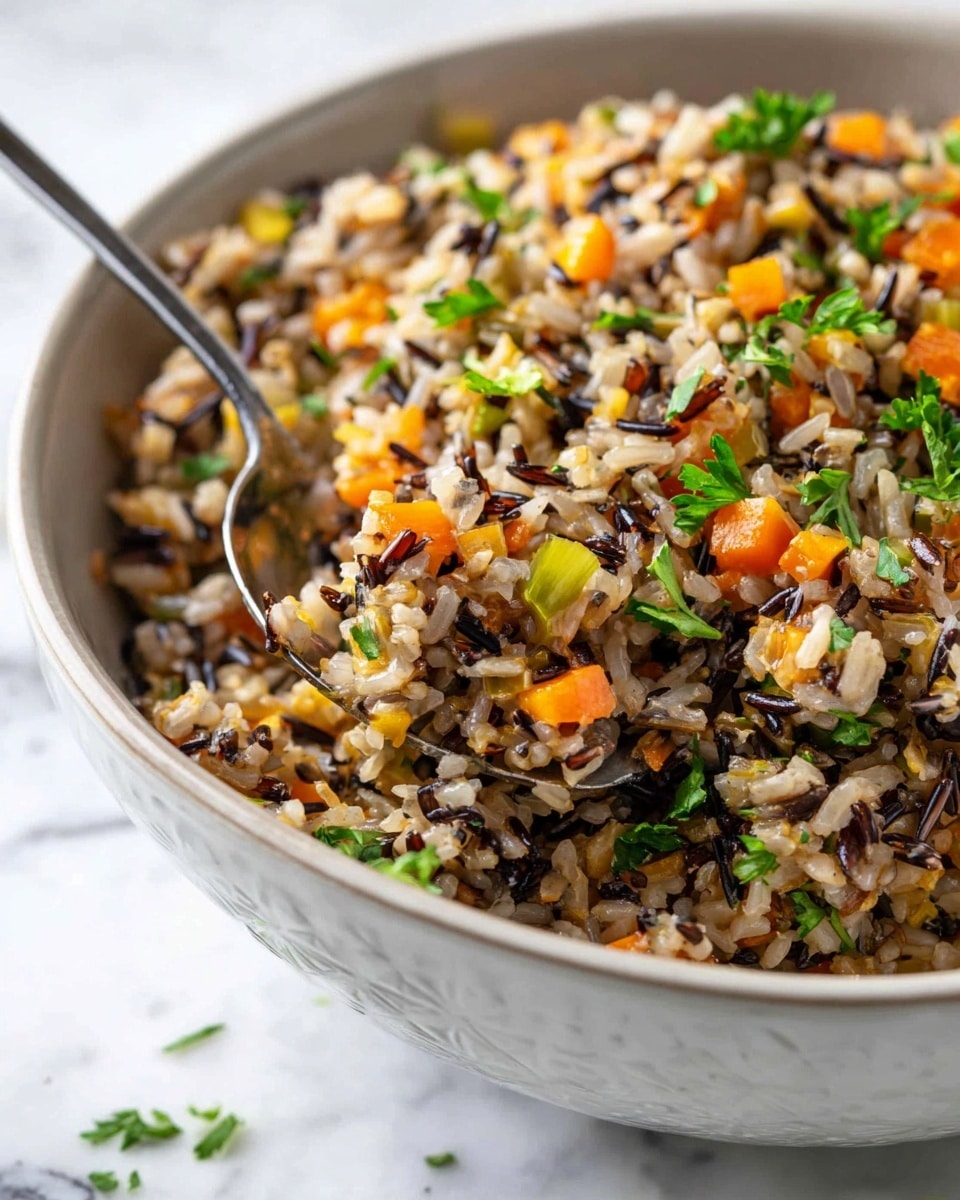If you’re searching for a wholesome, flavorful side that brings some zest to your table, then this Wild Rice Pilaf with Fresh Herbs and Vegetables Recipe is going to be your new go-to. I absolutely love how it combines nutty wild rice with vibrant veggies and fresh herbs—trust me, it’s not just healthy but incredibly comforting and satisfying. Stick with me, and I’ll walk you through everything you need to make this fan-freaking-tastic pilaf that my family goes crazy for!
Why You’ll Love This Recipe
- Flavorful and Nutritious: The earthy wild rice combined with fresh veggies and herbs creates a vibrant flavor profile that’s both hearty and healthy.
- Simple Ingredients: You probably already have most of these pantry staples and fresh produce on hand, making it an easy recipe to whip up any night.
- Versatile Side Dish: Whether you’re serving it with roasted chicken, grilled fish, or a veggie main, this pilaf complements so many meals.
- Hands-Off Cooking: Once you get the veggies sautéed and the broth added, this dish practically cooks itself while you prepare the rest of your meal.
Ingredients You’ll Need
Each ingredient plays a key part in making this wild rice pilaf taste just right. I like to use a wild rice blend for texture variety, and fresh herbs at the end really brighten the flavors. Here are some tips for picking the best ingredients.
- Olive oil: Use good quality extra virgin olive oil to get a subtle fruity flavor that works well with the veggies.
- Celery: Dice finely so it softens nicely and releases its classic aroma without overpowering the dish.
- Carrots: Fresh carrots add a touch of sweetness and vibrant color that brightens the pilaf visually and taste-wise.
- Onion: I prefer yellow or sweet onions here – they sauté beautifully until translucent, providing a lovely base flavor.
- Wild rice blend: A combo of wild and other rice grains gives the perfect chewy bite and depth of flavor.
- Vegetable broth: Homemade or low-sodium store-bought broth works best to keep the pilaf savory without being too salty.
- Fresh parsley: Chop just before serving so you get that fresh, grassy pop of herbaceous aroma.
Variations
This Wild Rice Pilaf with Fresh Herbs and Vegetables Recipe is fantastic as is, but I love to mix it up depending on the season or what’s in my fridge. Don’t hesitate to make it your own!
- Add toasted nuts or seeds: I sometimes toss in toasted pecans or slivered almonds for extra crunch and nuttiness—my family loves it.
- Swap herbs: If you don’t have parsley, fresh thyme or cilantro work beautifully and give a new twist.
- Mix in other veggies: Diced bell peppers or zucchini tossed in with the celery and carrots add color and freshness when in season.
- Make it vegan: This recipe is already vegetarian, and with vegetable broth, it’s naturally vegan-friendly.
How to Make Wild Rice Pilaf with Fresh Herbs and Vegetables Recipe
Step 1: Sauté the Vegetables Until Soft and Fragrant
Start by heating your skillet over medium-high heat with that lovely olive oil. When it’s shimmering, add your diced celery, carrots, and onions. Stir occasionally and cook until the onions turn translucent and the veggies soften—about 5 minutes. This step is key for building flavor, so don’t rush it. You’ll notice the kitchen fill with a warm, inviting aroma as the vegetables cook down gently.
Step 2: Toast the Wild Rice Blend
Once your veggies look tender, stir in the wild rice blend. Let it toast in the skillet, stirring now and then, until the rice swells slightly and the oil is absorbed—this usually takes a couple of minutes. Toasting really enhances the rice’s nutty flavor and adds subtle depth to the pilaf.
Step 3: Simmer the Rice in Broth
Next, pour in your vegetable broth, give everything a good stir, and cover the pan with a tight-fitting lid. Bring the mixture to a boil, then immediately reduce your heat to the lowest setting. Let it simmer gently for 45 to 50 minutes. Patience here is your friend — the slow simmer lets the rice soak up all that wonderful broth flavor and cook to tender perfection.
Step 4: Let the Pilaf Rest and Fluff
Once the simmering is done, take the pan off the heat but keep the lid on. Let the pilaf sit for 5 to 10 minutes so it can absorb any remaining liquid. This resting step ensures that the rice is perfectly cooked—moist but not soggy. Finally, fluff it up gently with a fork and sprinkle your fresh parsley all over before serving.
Pro Tips for Making Wild Rice Pilaf with Fresh Herbs and Vegetables Recipe
- Use a heavy-bottomed pan: This prevents hot spots that can scorch the rice, ensuring even cooking.
- Don’t skip toasting the rice: It adds a subtle smoky nuttiness I discovered by accident and now I never skip it!
- Cover tightly while simmering: A tight lid traps steam so the rice cooks evenly and stays moist.
- Let the pilaf rest after cooking: The resting time absorbs all the liquid and guarantees fluffy grains rather than mushy ones.
How to Serve Wild Rice Pilaf with Fresh Herbs and Vegetables Recipe

Garnishes
I love topping this pilaf with a sprinkle of freshly chopped parsley because it adds such a fresh, vibrant pop of green and flavor right at the end. Sometimes, I also like to add a few toasted pine nuts or a squeeze of fresh lemon juice to elevate it even more.
Side Dishes
My family often enjoys this pilaf alongside roasted chicken, grilled salmon, or even a simple lentil stew. It pairs beautifully with both meat and vegetarian mains, so it’s a versatile side that can round out any dinner plate.
Creative Ways to Present
To impress guests, I sometimes serve the pilaf in individual ramekins, unmolded onto the plate like a little rice cake. Adding a drizzle of herb-infused olive oil on top or a garnish of edible flowers makes it look restaurant-worthy without extra fuss.
Make Ahead and Storage
Storing Leftovers
I usually store leftover pilaf in an airtight container in the fridge where it keeps well for about 3 to 4 days. If it seems dry when you reheat it, just add a splash of broth or water to bring back moisture.
Freezing
This pilaf freezes nicely! I portion it into freezer-safe containers and freeze for up to 2 months. When thawed and reheated, it retains its texture surprisingly well, making it great for meal prep batches.
Reheating
To reheat, I add a splash of broth or water and warm it gently on the stovetop or in the microwave, stirring to fluff it up. Keeping it moist while reheating keeps the grains from turning tough or dry.
FAQs
-
Can I use plain wild rice instead of a blend?
Absolutely! Just keep in mind that plain wild rice typically takes longer to cook and has a firmer texture. You might need to increase the simmering time and liquid amount. I find blends easier for texture variety, but plain wild rice works perfectly well if you’re patient.
-
Is this recipe gluten-free?
Yes, wild rice and vegetables are naturally gluten-free, but always double-check your broth labels to ensure no gluten-containing ingredients have been added.
-
Can I batch cook and freeze this pilaf?
You sure can! It freezes well in portioned containers. Just thaw thoroughly and reheat with a bit of broth to keep it moist and fluffy.
-
What herbs work best besides parsley?
Fresh thyme, dill, or cilantro also bring lovely notes to this pilaf. Feel free to try whatever you have fresh—it’s a versatile recipe that takes well to many herbs.
Final Thoughts
This Wild Rice Pilaf with Fresh Herbs and Vegetables Recipe holds a special place in my kitchen because it’s both comforting and a little adventurous with all those textures and colors. It’s one of those dishes that feels like a warm hug while being fresh and wholesome at the same time. I’m confident that once you try it, you’ll be adding this recipe to your regular rotation, just like I have. Give it a go—you won’t regret it!
Print
Wild Rice Pilaf with Fresh Herbs and Vegetables Recipe
- Prep Time: 10 minutes
- Cook Time: 50 minutes
- Total Time: 1 hour
- Yield: 8 servings
- Category: Side Dish
- Method: Stovetop
- Cuisine: American
- Diet: Vegetarian
Description
This Wild Rice Pilaf is a hearty and flavorful side dish made from a blend of wild rice, sautéed vegetables, and fragrant herbs. Perfectly cooked on the stovetop, this dish offers a delightful mix of textures and earthy flavors, making it an excellent accompaniment to a variety of main courses or a wholesome vegetarian option on its own.
Ingredients
Vegetables
- 1/2 cup diced celery
- 1/2 cup diced carrots
- 3/4 cup diced onion
Grains and Broth
- 1 1/2 cups wild rice blend
- 2 2/3 cups vegetable broth
Other
- 1 tablespoon olive oil
- 1 – 2 tablespoons fresh parsley
Instructions
- Heat and Sauté Vegetables: Heat a large skillet over medium-high heat and add the olive oil. Once hot, add the diced celery, onion, and carrot. Sauté, stirring occasionally, until the onions become translucent and the vegetables soften, approximately 5 minutes.
- Add and Toast Rice: Stir in the wild rice blend to combine with the vegetables and oil. Allow the rice to toast slightly in the pan until the oil is fully absorbed, enhancing its nutty flavor.
- Add Broth and Simmer: Pour in the vegetable broth and cover the skillet with a lid. Increase the heat until the mixture comes to a boil, then immediately reduce the heat to low. Let the rice simmer gently for 45 to 50 minutes, or until the rice is tender and has absorbed most of the liquid.
- Rest and Absorb: Remove the skillet from heat and keep it covered. Let the rice sit undisturbed for 5 to 10 minutes to absorb any remaining broth and complete the cooking process.
- Fluff and Garnish: Using a fork, fluff the rice pilaf gently to separate grains. Garnish with fresh parsley before serving for a burst of color and fresh flavor.
Notes
- Using a wild rice blend can reduce cooking time compared to 100% wild rice.
- For added texture, consider stirring in toasted nuts like pecans or almonds after cooking.
- This pilaf pairs well with roasted meats, grilled vegetables, or as a vegetarian main dish.
- Ensure to keep the heat low during simmering to prevent the rice from burning or sticking to the pan.
Nutrition
- Serving Size: 1/8 of recipe (approx. 1 cup)
- Calories: 180
- Sugar: 3g
- Sodium: 320mg
- Fat: 4g
- Saturated Fat: 0.5g
- Unsaturated Fat: 3g
- Trans Fat: 0g
- Carbohydrates: 33g
- Fiber: 4g
- Protein: 5g
- Cholesterol: 0mg




Your email address will not be published. Required fields are marked *